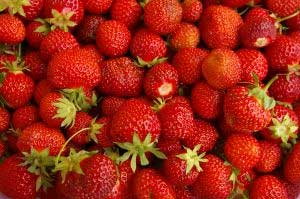Strawberries and blueberries harvested at or near full-ripe maturity tend to be less firm and more susceptible to bruising during harvest and transport. The objective of this research was to determine the fate of Escherichia coli O157:H7 and Salmonella on bruised and intact surfaces of whole strawberries and blueberries at shipping (2°C) and retail display (15.5°C) temperatures.
 Strawberries and blueberries were either purchased from a supermarket or were harvested immediately prior to use; they were bruised using established protocols, were spot inoculated, and were incubated at 2 and 15.5°C. Strawberries, subjected to modified atmospheres, were further transferred to bags and were sealed in with an initial atmosphere of ca. 10% CO2 and 5% O2. Strawberries were sampled at 0, 2, 5, and 24 h and on days 3 and 7; blueberries were sampled on days 0, 1, 3, and 7. After stomaching, samples were enumerated on nonselective and selective media, and populations were recorded as log CFU per berry. At both storage temperatures, population declines for both E. coli O157:H7 and Salmonella were seen under all conditions for strawberries. At 2 ± 2°C, E. coli O157:H7 and Salmonella populations on blueberries declined over 7 days under all conditions. At 15.5 ± 2°C, E. coli O157:H7 populations declined; however, Salmonella populations initially declined but increased to populations near or above initial populations over 7 days on blueberries. No overall significant differences were observed between bruised and intact treatments or between the two maturity levels for strawberries and blueberries. Modified atmospheric conditions did not affect the behavior of E. coli O157:H7 and Salmonella on strawberries at both temperatures.
Strawberries and blueberries were either purchased from a supermarket or were harvested immediately prior to use; they were bruised using established protocols, were spot inoculated, and were incubated at 2 and 15.5°C. Strawberries, subjected to modified atmospheres, were further transferred to bags and were sealed in with an initial atmosphere of ca. 10% CO2 and 5% O2. Strawberries were sampled at 0, 2, 5, and 24 h and on days 3 and 7; blueberries were sampled on days 0, 1, 3, and 7. After stomaching, samples were enumerated on nonselective and selective media, and populations were recorded as log CFU per berry. At both storage temperatures, population declines for both E. coli O157:H7 and Salmonella were seen under all conditions for strawberries. At 2 ± 2°C, E. coli O157:H7 and Salmonella populations on blueberries declined over 7 days under all conditions. At 15.5 ± 2°C, E. coli O157:H7 populations declined; however, Salmonella populations initially declined but increased to populations near or above initial populations over 7 days on blueberries. No overall significant differences were observed between bruised and intact treatments or between the two maturity levels for strawberries and blueberries. Modified atmospheric conditions did not affect the behavior of E. coli O157:H7 and Salmonella on strawberries at both temperatures.
 This research indicates that E. coli O157:H7 and Salmonella do not grow on strawberries at shipping or retail display temperatures, even when they are harvested at a maturity prone to bruising; however, Salmonella growth may occur on bruised full ripe blueberries under retail display temperatures.
This research indicates that E. coli O157:H7 and Salmonella do not grow on strawberries at shipping or retail display temperatures, even when they are harvested at a maturity prone to bruising; however, Salmonella growth may occur on bruised full ripe blueberries under retail display temperatures.
Journal of Food Protection®, Number 7, July 2014, pp. 1052-1240, pp. 1093-1101(9)
Nguyen, Thao P.1; Friedrich, Loretta M.1; Danyluk, Michelle D.2
http://www.ingentaconnect.com/content/iafp/jfp/2014/00000077/00000007/art00006
